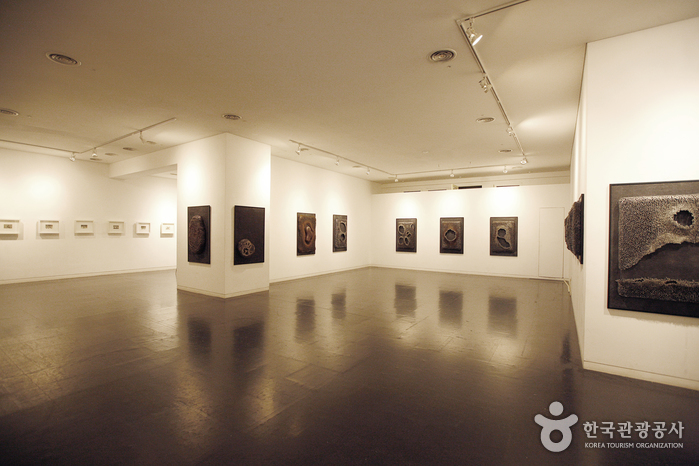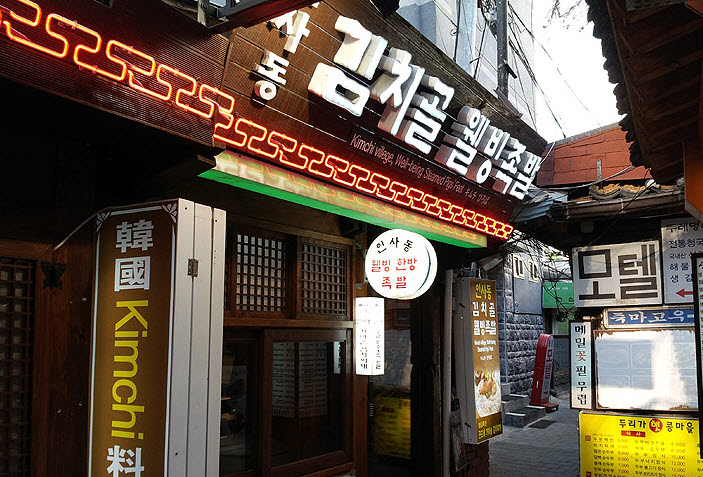Uke. Zamezip (육회자매집)
2.4Km 2023-12-22
200-4 Jong-ro, Jongno-gu, Seoul
This restaurant is located in a corner of Gwangjang Market's alley, and its main menu is Yukhoe/Beef Tartare (raw beef made by cutting small pieces of beef with various seasonings). The lightness of raw meat, which cannot be found in grilled meat, and the harmony with the seasoning are impressive. If you eat it with egg yolk, sprouts, and pears served together, you can feel the depth of the true taste of raw meat. If you want to try something a little more Korean-style, try 'Yuktangi,' which comes with Tangtangi (a dish made by pounding wild octopus on a cutting board and cutting it into pieces) and Yukhoe. However, the octopus Yuktangi moves around when the food is served, so you must be careful.
Harmony Mart - Insa Branch [Tax Refund Shop] (하모니마트 인사)
2.4Km 2024-04-17
1F (Gwanhun-dong), 38, Insadong 5-gil, Jongno-gu, Seoul
-
Olive Young - Sejong-ro Branch [Tax Refund Shop] (올리브영 세종로)
2.4Km 2024-04-16
161, Sejong-daero, Jongno-gu, Seoul
-
National Souvenirs Center [Tax Refund Shop] (한국관광명품점)
2.4Km 2024-04-23
14, Insadong 5-gil, Jongno-gu, Seoul
-
Seoul Art Center Gongpyeong Gallery (서울아트센터 공평갤러리)
2.4Km 2021-06-19
24, Insadong-gil, Jongno-gu, Seoul
+82-70-4214-0070
Opened in 1992, Seoul Art Center Gongpyeong Gallery is a 17,791㎡, two-story building with four exhibition halls. It is one of the main galleries of Insa-dong, displaying diverse artwork ranging from Western and Korean paintings to sculptures. Due to the great interest in Korean paintings, 2~3 of the annual long-term exhibitions focus solely on them.
Manjok Ohyang Jokbal Dongdaemun (만족오향족발 동대문)
2.4Km 2024-03-12
1-3FL, 9-4, Eulji-ro, 43-gil, Jung-gu, Seoul
+82-2-2271-0880
Situated between Dongdaemun and Dongdaemun Design Plaza (DDP), Manjok Ohyang Jokbal's Dongdaemun branch focuses on jokbal (braised pig's feet). In addition to their signature dish, jokbal (braised pigs' feet), they also serve a wide array of dishes including bossam (kimchi cabbage wraps with pork), jaengban guksu (jumbo sized buckwheat noodles), and mandu. As any dish ordered comes with mandu and sliced rice cake soup by default, it offers a satisfying ensemble.
Imun Seolnongtang (이문설농탕)
2.4Km 2025-06-18
38-13 Ujeongguk-ro, Jongno-gu, Seoul
+82-2-733-6526
Imun Seolnongtang has been serving its hearty seolleongtang for over a hundred years since it first opened in 1907. Even its name has a long history: the word imun comes from Imun-gol, the now-obsolete name of the restaurant’s location, and seolnongtang, an old variation of the word seolleongtang. During the Japanese colonial rule, the restaurant’s regular customers included Gijeong Son, the marathon gold-medalist at the 1936 Berlin Olympics. The meal served at this restaurante is reputed to stay consistent from the Japanese colonial period.
Kimchigol Well-being Bapsang(김치골웰빙밥상)
2.4Km 2024-10-14
22-5 Insadong-gil, Jongro-gu, Seoul
+82-2-720-6436
A restaurant where you can try kimchi, a Korean traditional dish, and meat. The representative menu is kimchi cabbage wraps with pork. This is a Korean cuisine located in Insa-dong, Seoul.
Gwanghuimun Gate (광희문)
2.4Km 2021-02-24
344, Toegye-ro, Jung-gu, Seoul
+82-2-3700-3900
Gwanghuimun Gate is said to have been originally constructed in 1396, the 5th year of King Taejo, at the southeast of the capital city. It was often referred to as Sugumun Gate (water channel gate) and was actually used as a Sigumun, literally meaning “corpse gate,” as funeral processions passed through this gate when exiting to the east.
During the Imjin War (1592-1598), the fortress gate was destroyed to such a degree that it made finding the original location close to impossible. Nevertheless, reconstruction efforts were started in 1711 (37th year of King Sukjong) and the gate was restored together with the gate's watchtower. Gwanghuimun Gate remained intact even when the fortress walls were demolished to build tram tracks during the Japanese occupation, but it was later damaged during the Korean War and left neglected. In 1975, restoration work was carried out to relocate Gwanghuimun Gate to a site 15 meters south of its original location since it stood in the middle of the road.

![Harmony Mart - Insa Branch [Tax Refund Shop] (하모니마트 인사)](http://tong.visitkorea.or.kr/cms/resource/79/2888079_image2_1.jpg)



 English
English
 한국어
한국어 日本語
日本語 中文(简体)
中文(简体) Deutsch
Deutsch Français
Français Español
Español Русский
Русский